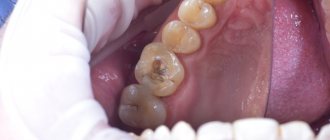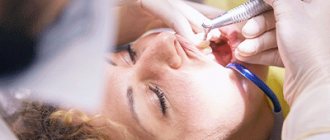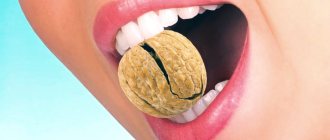05.08.2021 739
There are a large number of reasons why a person could potentially suffer such an injury. In this case, there can be a lot of unpleasant consequences - from a simple violation of aesthetics to severe pain, hypersensitivity to cold or hot food.
Let's look at why chips may appear and what the consequences are. We will also touch upon the issue of prompt home treatment in such a situation, as well as a method for solving the problem by a professional dentist.
The most common causes of chipped teeth
Human teeth are very strong. They are well protected from external mechanical influences and are designed specifically to cope with tough, fibrous foods. However, there are many factors that could potentially lead to chipping.
When you make an appointment with your dentist, he or she will conduct a thorough examination of your mouth and determine what may be causing the problem.
Typically, chips occur as a result of several common reasons:
- Inattentive food selection. You can chip a tooth when chewing if there is something too hard inside the food. It could be a small stone, a mollusk shell, and much more. The danger is especially great if you actively chew food and cannot sense in time that something is wrong.
- External trauma. Often happens when hit, fallen, or involved in a traffic accident. There is also a danger of collateral injuries. This may include tooth dislocation, gum damage, wounds on the tongue, or the oral mucosa.
It is also important to understand that the strength of a person's teeth may vary depending on many factors. There are several factors that significantly increase the likelihood of chipping:
- Violation of the acidity of the oral cavity.
- Enamel diseases.
- Cracks on the surface of the tooth.
- Severe damage to the seal.
- Malocclusion and other congenital deformities.
- Bruxism.
People with bad habits are also at risk. Excessive consumption of alcohol and smoking leads to teeth becoming much more fragile.
If a person belongs to a risk group, a chip may appear even from not the strongest pressure. Therefore, it is worth monitoring the condition of your teeth and taking timely measures. So, if you suffer from bruxism and grind your teeth a lot at night, you should choose mouthguards on the advice of your dentist to reduce the negative impact.
Some people also experience chipping simply because they are inattentive to their diet. They actively chew on candy and nuts and open their jaws too much while chewing food, which significantly increases the potential for injury.
Sometimes the problem takes on a systemic nature and indicates negative changes in the body, a lack of certain nutrients from food. In this case, the answer to the question of why teeth may break off specifically in your case is given by a comprehensive examination.
Types of chips
In clinical practice, there are several types of chips, differing in the tissues affected:
Chips within the enamel
Trauma and disruption of integrity occurs within the enamel. In this case, symptoms do not appear, even the chip itself may be invisible. But with significant chips, pain, increased sensitivity of the teeth, and a feeling of soreness may appear.
Chip within dentin
As a result of trauma, the dentin layer is damaged. Most often, the anterior group of teeth are damaged during falls and can be combined with other injuries. Chips within the enamel require timely treatment, otherwise complications will not be long in coming.
Chips involving the neurovascular bundle
These are significant chips of the enamel, which expose the pulp. Which is associated with severe pain, bleeding and other symptoms. In this case, urgent medical attention and treatment is necessary.
Signs of chipping
In most cases, chips can be identified by visual inspection or when the patient simply touches the tooth with his tongue. But there are also situations when the chip is located on the inside, difficult to reach and difficult to inspect.
Such situations reveal themselves as a whole list of symptoms. These include the following:
- Problems with chewing food, something constantly gets in the way, pieces begin to get stuck inside the tooth.
- The loss of a previously installed filling (a chip forms on the remaining part of the tooth and it simply cannot hold on normally).
- Severe sensitivity when eating - a reaction occurs to sour, salty, cold, hot foods.
- Acute pain and severe pulsation at the site of injury.
It is worth understanding that the size and nature of chips may vary. Because of this, some patients may not even notice the problem, while others experience severe pain - their nerve is exposed. Regardless of the degree of destruction, you should consult a doctor as soon as possible and conduct a detailed examination of the oral cavity.
What should you do first if a tooth is damaged?
Of course, if you receive slight damage to the enamel or detect microcracks, you should not escalate the situation and immediately run to the 24-hour dental care office; just make an appointment with the dentist on any convenient date. But in case of moderate or severe tooth defects, it is necessary to consult a doctor as soon as possible, having first provided first aid to yourself.
Cold compress for a damaged tooth
To do this, you need to rinse your mouth with a saline or soda solution to remove any remaining food, in case of serious damage, apply a cool compress that will prevent swelling, and in case of gum injury, use a disinfectant pad with hydrogen peroxide. If the pain is severe and there are no contraindications, a painkiller will come to the rescue. And then – straight to the doctor!
Main types of damage
The choice of treatment method directly depends on how badly the patient’s tooth is damaged. There are several common manifestations, which include the following:
Crack in the enamel.
- The enamel itself is very durable, which is not surprising - it acts as the main protective mechanism throughout life. There are many factors that can lead to the appearance of microcracks in the surface. From the outside, they are often very difficult to distinguish, but they can not only increase in size, but also become the cause of common oral diseases, such as caries. Food gets packed into the cracked areas and bacteria actively multiply in them. At the same time, the strength becomes less and the likelihood of a large chip only increases. The standard cause of the problem is an incorrect diet, eating a lot of sweets.
- Chipping of part of the enamel. A lacuna appears on the tooth, which is often clearly visible even during an external examination. There is pain and an acute reaction when eating various types of food. It is worth consulting a doctor as soon as possible to prevent the problem from getting worse.
- Skol. It differs in location and size. Depending on the nature of the injury, it appears on both the external and internal sides of the tooth and is clearly visible during the initial visual examination. The injury is accompanied by hypersensitivity, severe pain, pulsation and other noticeable negative manifestations.
Injuries in which the tooth is chipped at the root are also common. They are the most dangerous for humans, because in this case the nerve is exposed and the patient begins to experience severe physical suffering. Further actions in case of injury will depend on the condition of the remaining part of the tooth. Removal of the root is required, but sometimes it is possible to use the remainder as a base for a crown.
In our clinic, doctors fight for every tooth. We do everything to restore aesthetics, chewing ability and relieve you of pain.
Restoration methods in dentistry
The depth of damage directly affects the choice of methods of treatment and restoration of the tooth. So, if we are talking about large chips right up to the gums, you can consider the following options for solving aesthetic and functional problems:
- artistic restoration (direct composite veneers) – a specialist restores the shape of the crown by layer-by-layer application of a light-curing composite material, exactly the same as that used for light fillings. This is the best option if the chip is located near the gum, but does not affect most of the tooth,
The defect can be corrected by installing a light-composite material - restoration tab – you can restore the shape using the tab, among other things. Essentially, it is a large filling that is made from impressions in a laboratory. It replaces part of the crown, thereby restoring its shape and functionality,
- veneers and lumineers - the possibility of using this method should be considered based on more accurate characteristics of the clinical picture. In some cases, it is impossible to hide large defects with thin ceramic or zirconium plates. Veneers and ultra-thin lumineers are usually used to completely transform your smile. With the help of such plates you can successfully disguise minor external flaws and make your smile perfect. But before installing such onlays, you will have to grind off the enamel layer in order to preserve the anatomical parameters of the teeth. However, lumineers allow you to do without this procedure, since their thickness is only 0.3-0.4 mm1,
Veneers can be used to treat this type of damage. - artificial crown - if the visible part is almost completely destroyed, it will be necessary to install a crown, possibly with the preliminary installation of a pin or stump tab to strengthen the connection of the prosthesis with the root system. Well, if, on top of everything else, the root is seriously damaged and requires removal, then the next best solution would be to install a crown on the implant. As an alternative, one can also consider bridge-like prosthetics based on row elements adjacent to the defect.
“I had this happen. One tooth on the upper jaw first chipped. It wasn’t noticeable, I didn’t feel any pain either, so I decided it was nothing to worry about. After a couple of months I ate nuts, bit poorly, and in the end the half tooth was gone! I had to get a crown, but the doctor said it wouldn’t be possible to build it up. True, he was initially dead for me, but it’s still a shame.”
Alexey, from correspondence on the 32top.ru forum
In all these cases, appropriate treatment is carried out first. In case of chips and cracks in the enamel, it is worth undergoing an examination to determine the condition of the enamel layer. Perhaps the doctor will consider it necessary to prescribe a course of fluoridation and remineralization to strengthen it.
If the pulp is seriously affected, it is likely that it will have to be removed. Partially or completely - depends on the depth of the damage. This is a neurovascular bundle that provides nutrition and vital activity to the crown. Without the nerve, it darkens, becomes brittle and breaks down faster. After depulpation, the canals are also treated and filled, and a pin or stump inlay can be installed.
First aid at home for a chipped tooth
Sometimes the injury occurs late in the evening or it is impossible to make an appointment with a doctor the next day. In this case, you need to take the right steps to prevent infection, relieve pain, and rule out most other potential problems.
At home, several actions are taken depending on how severe your injury is and what signs it is accompanied by:
- Mouth rinse. Note that as soon as a tooth chips, you need to stop swallowing saliva until you rinse your mouth. Rinsing is done gently, without creating a vacuum or strong pressure on the affected side. To ensure quick disinfection, you can also use a chlorhexidine solution.
- Application of a special compress. This is necessary in order to minimize swelling. At home, use a towel soaked in cold water or a special ice bag, which we recommend keeping on hand. If there is no such bag, put the ice in a bag and wrap it with cloth. The same towel will work well.
- Taking painkillers. This allows for temporary relief of pain. If you do not have any contraindications, you can use products with an additional anti-inflammatory effect. These include such as Ibuprofen, Dolaren and others. When the patient does not have individual intolerance to drugs, and the chip is large, it is practiced to place a tampon soaked in lidocaine or novocaine inside. The measure is needed to significantly reduce pain and prevent pathogenic bacteria from entering the chipped tooth.
A special situation arises if a person experiences severe bleeding. In this case, rinsing is contraindicated. The tooth itself can be covered with a turunda for additional protection.
If you have a chip, you need to see a doctor as soon as possible. When a tooth is chipped at the root, we recommend saving the remaining part - it will be needed for subsequent restorative procedures.
It is not recommended to delay going to the doctor. The reason is that there is a high probability of infection and gradual further spread of the process.
What to do if part of a tooth breaks off?
Visit a dental clinic as soon as possible after your injury. To completely restore damaged tissue and prevent the situation from getting worse, you need to act quickly. If a similar misfortune happens to a person nearby, he may need first aid.
First aid
In case of chipped teeth, specialized medical care is required, but in the first minutes after the injury, you can take a number of measures on your own. Rinse your mouth with warm water (use boiled water) to remove pieces of food and enamel particles. If the gum is damaged and bleeding occurs, apply a sterile bandage to the wound. To reduce pain and swelling, you can cool the tissues surrounding the injured area with ice or a cloth soaked in cold water. If pain causes significant discomfort, take an analgesic (a group of non-steroidal anti-inflammatory drugs).
Therapy at the dental center
To restore the healthy appearance of teeth, dentists use various restoration methods. If there is a minor chip of the enamel, composite materials are used that harden when exposed to light. From the same materials, the doctor creates a dental inlay, which is then attached to the surface of the tooth with glue if the dentin is damaged due to chipping.
Dental inlays are microprostheses, so their creation requires a pre-made impression. But in some clinics it is possible to make a composite inlay in less than a day. Thanks to this, the time spent on treatment is significantly reduced, and the patient stops experiencing pain much faster. This is especially important if there is an injury to the front teeth, and it is also necessary to restore the aesthetic appearance of the dentition.
Veneers are special microprostheses made of various materials (most often ceramics) that help quickly and efficiently correct chipped front teeth on their outer side. Minor chips of the molars are corrected with fillings, and sharp edges of the chip line are smoothed by grinding.
If the pulp is injured, the doctor performs an intervention called depulpation. It helps avoid inflammation and relieves pain. In such a situation, the tooth is restored using a pin. This device reduces the pressure exerted on the injured tooth and prevents its further destruction.
Chipped molars
The method of restoration of molars for chipped teeth is chosen by the dentist individually and depends on the location and degree of injury. Chips on the inside of molars are eliminated by installing fillings, and on the outside, damage is restored using composite materials. It is very convenient to correct damaged lateral teeth by installing metal-ceramic crowns. This material is very durable and can withstand significant loads when chewing food.
Chipped front teeth
If a front tooth is chipped, patients also suffer from psychological discomfort. If the frontal part of the dentition is affected, people may experience difficulty smiling and talking with others, and over time, speech distortions and facial expression disturbances may occur. Therefore, if a tooth is chipped, it is very important to visit the dentist on time.
If the enamel and dentin are damaged when a front tooth is chipped, a filling is installed and the sharp edges of the chip line are polished. When the pulp chamber is injured, the doctor performs depulpation and then fills the tooth (sometimes installing a pin). In some clinical situations, the use of microprostheses (veneers and lumineers) or composite dental inlays is required.
Enamel chip
Enamel is one of the hardest tissues of our body, but despite this, it requires constant and careful care. It is important to monitor its safety and remember the factors that contribute to its destruction. Cracks in enamel can occur due to excess consumption of carbohydrates, excessive consumption of solid foods, poor personal hygiene and bad habits. If after the formation of a chip or crack the dentin is not damaged, people are in no hurry to see a dentist due to the almost complete absence of symptoms. Minimal discomfort in the oral cavity is also a reason to visit a doctor, this way you can avoid many negative consequences and prevent the destruction of dental tissues.
Dentin chip
Dentin is the part of dental tissue located under the enamel that protects the nerve and pulp chamber. In terms of hardness, it is somewhat inferior to enamel. If a tooth is moderately chipped, destruction of dentin is possible, which is why the pathological process penetrates into the pulp chamber. When dentin is damaged during a tooth chip, the sensitivity of the damaged tooth sharply increases (hyperesthesia) when consuming hot, cold, sour, etc.
Chip exposing the pulp
If the pulp chamber is damaged, sharp pain occurs, which is poorly relieved with painkillers. It is recommended to visit a dentist as soon as possible. The doctor removes the pulp, cleans all the canals, removes the nerve, and then begins to restore the injured tooth. We invite you to visit our dentistry! We provide dental services near the Krasnye Vorota, Baumanskaya, Tretyakovskaya metro stations, as well as Novokuznetsk.
Types of professional medical care
When a patient sees a dentist, he carefully assesses the situation. Depending on the initial state, there may be many options for action. These include:
- Remineralization. This method is used if a small crack occurs in the enamel. Either an individual tooth or the entire row can be treated with a special strengthening preparation. A special product is used, which contains a sufficient amount of various trace elements and minerals. The technology allows you to get rid of cracks and significantly strengthen the tooth.
- Application of preparations with a high fluoride content. This is also necessary in order to significantly improve the overall condition of the enamel. The patient is prescribed a special mouthguard, onto which such material is applied. This makes it possible to provide treatment around the clock.
- Artistic restoration. This method is needed specifically to restore the aesthetics of the oral cavity. The method is used if the chip is small. Modern technologies are needed to restore the shine of enamel. The color of the restored fragment will not differ from the surrounding row.
- Installation of additional cover. One of the most common methods of restoring dental aesthetics without the use of complex and lengthy operations. We use various types of overlays – these can be lumineers and veneers. The composition, duration of use, appearance and many other characteristics differ.
- Placement of a special crown. The approach can be used if the upper part of the tooth is not severely damaged. The remaining part of the tooth in this case begins to be used as a natural support. The crown will be stable and will completely fill the vacated space.
- Using special tabs. At the same time, the order for the production of such an onlay is transferred to a special dental laboratory. The overlay is very durable and restores chewing ability.
Sometimes, as a result of strong pressure, the tooth root itself breaks. This is the most serious situation in which proper removal of tooth remains and subsequent implantation will be required. A base is installed in the gum, on which a special crown is fixed.
Special cases
Some teeth are restored in their own ways. Let's look at them.
Wisdom tooth
If a chip appears on this tooth, it is not restored. The procedure makes no sense. The fact is that this chewing organ is not involved in the chewing process and is not important for the species. Dentists remove a chipped wisdom tooth.
Front tooth
The situation with chipped front teeth seems deplorable to public citizens. In this case, the dentist may offer different treatment methods. For example, artistic restoration. The dentist will use a paste to select the desired color and restore the tooth. The material is resistant, durable and imitates naturalness well. The doctor will fix the applied layer with special light radiation. It is impossible to determine from the appearance that the patient’s tooth has been restored using extensions.
The second way to restore a tooth is to use a veneer. It is used for serious injuries. The material is strong, resistant, durable and does not change color over time.
In the third case, they resort to installing a crown. For these purposes, zirconium oxide, ceramics or metal ceramics are used. The choice of material is influenced by the patient’s opinion and ability to pay.
Lateral teeth
The same restoration methods can be used on the side teeth as on the front teeth. However, this is not entirely justified. These teeth are hidden from the eyes of others. Therefore, to restore them, you can use a regular filling. But it is better to resort to the extension method. Veneers are not installed on lateral teeth.
If a nerve has opened up on a side tooth, the dentist will first do an antiseptic treatment, perhaps remove the diseased nerve or the entire tooth and make a new one again.
Baby tooth
A parent often makes the mistake of thinking that it is not worth taking a child to the hospital with baby teeth. It's in vain. If your baby teeth are chipped or cracked, your doctor will stop further decay using a filling or preservative gel. For chipped incisors, a special gel is mainly used. Healthy baby teeth will lead to healthy permanent teeth.
Children are especially often injured. This happens due to falls or blows. The resulting chips lead to further stomatitis and increase tooth sensitivity. Therefore, a visit to your pediatrician is important.
It is important for the child to carry out the following pre-medical measures:
- Calm a frightened child.
- Give your child water to rinse his teeth.
- If soft tissues are damaged, disinfect them.
- Be sure to save the broken tooth for the doctor.
Within the first 24 hours, a child with a chipped tooth should be shown to a doctor. During the appointment, the doctor will most likely take pictures of the baby, which will help check the condition of the roots and soft tissues. For chipped incisors, a special gel is mainly used.
Special case - vertical crack
The vertical crack does not appear to be dangerous. It's a lie. It seriously hurts the pulp. As a result, it is not possible to restore the enamel with a filling. In serious cases, the patient feels that one half of the tooth is loose. In serious cases, the patient feels that one half of the tooth is loose.
In the case of a small crack, pressure is applied to the teeth. As a result, the tissue gradually loses its integrity. The result of this state of affairs is a big chip. If you go to the dentist, they will cover up a small crack, thereby restoring the enamel and health. If this action does not help, the doctor may install veneers or a crown.
Chip in the front row of teeth
Typically, such chips occur when biting or a strong blow. Even the smallest defects are noticeable on the front row, so a small chip can cause not only discomfort, but also psychological problems. Also, the aesthetics are spoiled by microcracks, which over time begin to turn black and become more and more visible.
When small cracks appear, fluoridation and mineralization are usually sufficient. If the enamel has been severely damaged and part of the tooth has broken off, installing an artificial veneer would be a good solution. In our clinic, your dentist will install veneers or ultraneers for you. If the damage is severe, the only option is removal, prosthetics or implantation.
Types of chips
There are different types of injuries, but their main classification involves division by depth and scale of damage. Experts identify an enamel chip - a minor superficial violation of the integrity of the crown. But if a tooth breaks off at the root, dentin and even pulp may already be affected. The case is serious, and urgent assistance from a specialist is needed here. In case of deep damage that seriously affects the root system, the tooth will have to be completely removed and an implant with a crown or a bridge will be placed in its place.
The photo shows chips that affected the dentin and pulp of the tooth.
Chip on the side of the tooth
Most often occurs during chewing. Since this is a side invisible to prying eyes, many patients decide not to see a doctor at all and live with such a defect.
This approach is wrong for several reasons:
- A chip can easily become a site for the development of caries and the situation will only get worse.
- Due to the strong pressure on the damaged area, further destruction is possible.
- There is a risk of injury to the tongue when it comes into contact with a sharp edge and the onset of an inflammatory process.
The advantage of working with the sides is that aesthetics matter less. Therefore, you can get by with less expensive materials during the restoration process. The strength itself will not become lower.
Occurrence of a vertical crack
Sometimes a chip does not appear, but the tooth cracks vertically - this is very noticeable from the outside. The choice of treatment method will be based on how severely the enamel is damaged and how deep the crack goes.
There are three main treatment options:
- Standard filling.
- Installation of external onlays on the tooth.
- Removal and subsequent implantation.
It is important to resolve the problem quickly before numerous potential complications arise.
Do children need to treat chipped teeth?
Parents often ask the question of what to do if a child’s tooth chips. Many people believe that baby teeth are not that important and therefore need not be treated. The logic is simple - they will fall out on their own and be replaced by indigenous ones.
But you should not be guided by this logic for a simple reason - the condition of the baby tooth greatly affects the formation of the molar. The onset of the inflammatory process and infection of the tooth lead to inflammation of the gums. This can negatively affect the formation of permanent dentition.
What complications can you encounter due to chips?
If you notice a chip on your tooth, you should contact your dentist as soon as possible to have it repaired. And it's not just about aesthetics. Delay will cost the health of your smile. There are several potential complications that have to be encountered in medical practice:
- Tooth infection. Any pathogenic bacteria can penetrate through the open pulp. As a result, the person not only suffers from pain. Previously, only a slightly damaged tooth that could still be saved had to be removed.
- Periodontitis. This is the name of a strong inflammatory process that occurs in the tissues surrounding the apex of the tooth root. Treatment is long and complex and may require removal.
- Formation of neoplasm. They can be of either granulosa or cystic type and pose a serious danger to the human body.
- Changes in bite and dental mobility. It is formed due to the fact that it becomes inconvenient for a person to close his jaws. There are many types of complications due to this reason.
The development of severe sensitivity to food, which over time develops into pain, is also characteristic. You cannot delay treatment - contact a doctor as soon as possible.
How to prevent chipping
There are several tips that dentists give to patients in order to keep their teeth intact for as long as possible. These include:
- Maintain good oral hygiene. Use high-quality pastes, rinses, special gels as recommended by your doctor. The enamel needs to be strengthened.
- Visit your dentist regularly. It is necessary to carry out proper dental treatment, to ensure that the enamel does not crack or wear off.
- Monitor the condition of the gastrointestinal tract and other body systems. Particular attention should be paid to the functioning of the endocrine and immune systems. Changes in the balance of acidity in the oral cavity should not be allowed.
- Form your diet correctly. It should include foods that stimulate strong bones and teeth.
- Correct your bite. Due to improper bite, chips appear quite often, and the enamel itself is worn away ahead of time. It is cheaper to get braces than to periodically spend money on veneers, implantation, remineralization and other dental procedures.
- Cure bruxism. This may require you to wear special mouthguards.
Equally important is the advice to monitor what and how you eat. Try not to chew on anything too hard—candy, nuts, and more. If you chew carefully and watch what you eat, the likelihood of chipping will be much less.
Prevention
To prevent chipping of a part of the tooth you need to:
- Treat caries regularly.
- Avoid mechanical damage.
- Eat right and in moderation.
- Do not delay correcting your bite.
- Monitor the health.
A chipped tooth is a fixable matter. It is better to heal than to have complications later.
Sources used:
- Klyomin V. A., Borisenko A. V., Ishchenko P. V. Combined dental fillings. MIA, 2008
- Practical therapeutic dentistry" (Nikolaev A.)
- Scheller-Sheridan C (8 May 2013). Basic Guide to Dental Materials. John Wiley & Sons.
- Faculty of Dentistry and Medical Technologies St. Petersburg State University
We will quickly and efficiently deal with chipped teeth
At our clinic, doctors are ready to quickly treat chipped teeth and any other injuries or damage. We use advanced techniques - from remineralization to installation of onlays and implantation.
We offer our clients affordable prices and are always ready to answer any questions they may have. We will relieve you of pain, restore the aesthetics of your smile and the ability to chew normally. We have affordable prices and special offers.
To learn more about the treatment process and make an appointment with a dentist at a convenient time, leave a request on the website or call us at the numbers provided.
Why do pieces of teeth break off?
There may be several reasons why a piece of tooth broke off:
- Mechanical injury - blows and bruises, eating too hard or viscous food. In addition, the bad habit of gnawing hard objects (nails, pens, seeds, etc.) can lead to injury.
- A change in the normal acid-base balance in the mouth, leading to destruction or thinning of the enamel.
- Demineralization of enamel, which occurs as a result of poor nutrition or disruption of the normal hormonal levels of the body (during pregnancy, thyroid diseases, diabetes, etc.).
- Bite defects.
- Incorrect or excessive functional loads on the jaw, arising from abnormal position of teeth in a row or for other reasons.
- Carious lesions of dental tissues.
- Non-carious defects leading to the destruction of enamel - for example, wedge-shaped defect or hypoplasia.
- Incorrectly installed seals.
- Bruxism (teeth grinding).
Regardless of what caused the chipping, you must immediately contact your dentist - the doctor will help you determine exactly why pieces of teeth are breaking off and eliminate both the cause and its effect.











